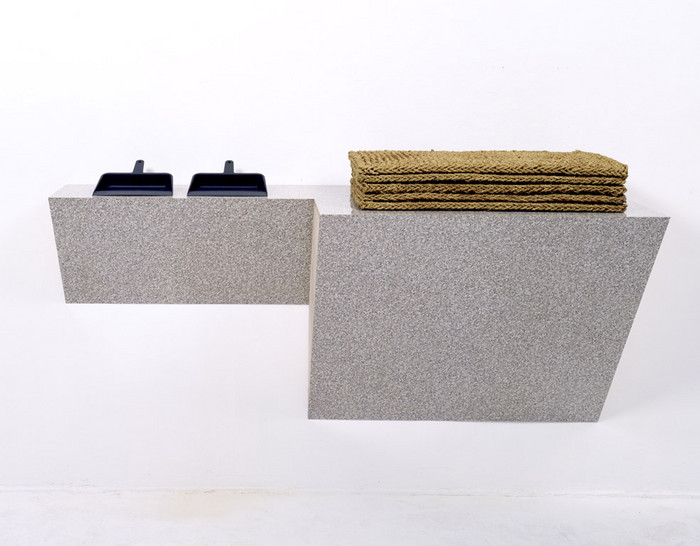Haim Steinbach

Haim Steinbach
untitled (dust pans, door mats) #A4, 1990
Wooden laminate, objects
110,5 x 215,9 x 80 cm
Acquired/Erworben 2003
Haim Steinbach juxtaposes a whole variety of objects by arranging them on specially made shelves, thus putting them on display. The question about cultural customs suddenly becomes surprisingly urgent when Steinbach displays two dustpans and five doormats on a shelf with a surface like a terrazzo floor and with graded dimensions relating to the base area of the objects. But the work shows us precisely how object values change when their functional use is transformed into a cultural one and thus directs our attention towards the formal object qualities. The doubling up or stacking of dustpans and mats emphasizes their color, form and qualities, making them into exhibition pieces with aesthetic and symbolic value: even a dustpan and a doormat are more than functional objects. They carry distinctive traits that convey as much information about life-styles and class-specific milieus as a Meißen porcelain dinner service. In the present case, they suggest a milieu in which cleanliness is still next to godliness. Steinbach stylizes positively banal things radically by detaching them from their assigned economic logic and thus revealing their social logic.
Haim Steinbach, zweifacher Teilnehmer der documenta Kassel, bringt unterschiedlichste Objekte in Nachbarschaft, indem er sie auf speziell angefertigte Regale stellt. Sein Verfahren gleicht der üblichen privaten Gewohnheit, Tassen, Plüschtiere oder anderen Nippes auf Kommoden zu. Doch ist am Beispiel Untitled (dust pans, doormats) # 4a auffällig, wie sich Objektwerte verändern, wenn sich der funktionale Gebrauch in einen kulturellen wandelt. Aus ihrer wirtschaftlichen Logik entführt, offenbart sich der ästhetische Wert der Dinge, sind sie doch alle Träger kultureller oder gesellschaftlicher Unterscheidungsmerkmale, die über Lebensstile Auskunft geben. Steinbach hat als Oberfläche für sein auffällig skulpturales Wandregal ein Material gewählt, dass wir mit klinischen, aseptisch-keimfreien Räumen verbinden. Die darauf angeordneten Kehrschaufeln und Fußmatten assoziieren jedoch das Gegenteil: Staub, Schmutz, Krankheitskeime. Der New Yorker Künstler formuliert hier ein prekäres Bild der Oberflächenfixiertheit amerikanische Gesellschaft und damit verbundener widersprüchlicher Moralvorstellungen.
untitled (dust pans, door mats) #A4, 1990
Wooden laminate, objects
110,5 x 215,9 x 80 cm
Acquired/Erworben 2003
Haim Steinbach juxtaposes a whole variety of objects by arranging them on specially made shelves, thus putting them on display. The question about cultural customs suddenly becomes surprisingly urgent when Steinbach displays two dustpans and five doormats on a shelf with a surface like a terrazzo floor and with graded dimensions relating to the base area of the objects. But the work shows us precisely how object values change when their functional use is transformed into a cultural one and thus directs our attention towards the formal object qualities. The doubling up or stacking of dustpans and mats emphasizes their color, form and qualities, making them into exhibition pieces with aesthetic and symbolic value: even a dustpan and a doormat are more than functional objects. They carry distinctive traits that convey as much information about life-styles and class-specific milieus as a Meißen porcelain dinner service. In the present case, they suggest a milieu in which cleanliness is still next to godliness. Steinbach stylizes positively banal things radically by detaching them from their assigned economic logic and thus revealing their social logic.
Haim Steinbach, zweifacher Teilnehmer der documenta Kassel, bringt unterschiedlichste Objekte in Nachbarschaft, indem er sie auf speziell angefertigte Regale stellt. Sein Verfahren gleicht der üblichen privaten Gewohnheit, Tassen, Plüschtiere oder anderen Nippes auf Kommoden zu. Doch ist am Beispiel Untitled (dust pans, doormats) # 4a auffällig, wie sich Objektwerte verändern, wenn sich der funktionale Gebrauch in einen kulturellen wandelt. Aus ihrer wirtschaftlichen Logik entführt, offenbart sich der ästhetische Wert der Dinge, sind sie doch alle Träger kultureller oder gesellschaftlicher Unterscheidungsmerkmale, die über Lebensstile Auskunft geben. Steinbach hat als Oberfläche für sein auffällig skulpturales Wandregal ein Material gewählt, dass wir mit klinischen, aseptisch-keimfreien Räumen verbinden. Die darauf angeordneten Kehrschaufeln und Fußmatten assoziieren jedoch das Gegenteil: Staub, Schmutz, Krankheitskeime. Der New Yorker Künstler formuliert hier ein prekäres Bild der Oberflächenfixiertheit amerikanische Gesellschaft und damit verbundener widersprüchlicher Moralvorstellungen.
Tag: Haim Steinbach
